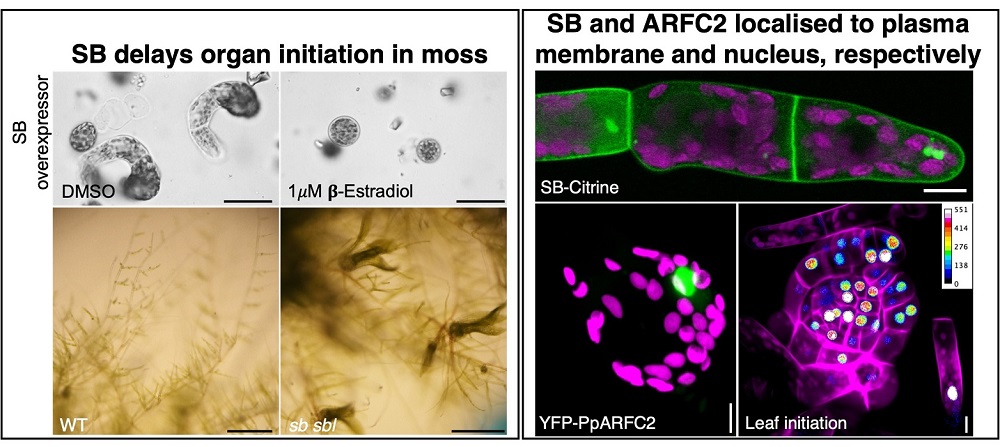[Ooi-Kock Teh] How to Sleep a Hundred Years - Lessons from a Sleeping Beauty
POST:The fairy tale of Sleeping Beauty (SB) by the Grimm Brothers tells the story of an unfortunate princess who was cursed by a bewitched fairy and doomed to sleep for a hundred years. As a famous bedtime story, the story of Sleeping Beauty surely evokes childhood memories. However, recent findings from a scientific collaboration amongst Hokkaido University, Saitama University (both in JAPAN), and Academia Sinica (TAIWAN) put a different light on the villain of the story. Searching for factors that control cell polarity in plants, research teams led by Fujita Tomomichi (Hokkaido University) and Teh Ooi-Kock (Academia Sinica) uncovered two similar arabinogalactan proteins - small proteins harboring a sugar moiety - that yo-yo between a witch and a Beauty (of nature).
When present in large quantities, these two small proteins seem to cast a spell on the moss (Physcomitrium patens) that put it into a deep sleep. Because of their pronounced dormancy effects, the scientists named the two proteins Sleeping Beauty (SB) and SB-Like (SBL). Intriguingly, protein sequences of SB and SBL do not resemble any other proteins in plants, rendering functional prediction difficult and the question as to how the cell surface-localised SBs stop cell growth unanswered.
The breakthrough came when the researchers noticed that mutants lacking both SB and SBL generated their leaf-like gametophore structures a few days earlier than the control plants with functional SB and SBL. “It was a very subtle growth defect that I almost missed”, said Dr. Teh, the leading author of the study. “I recall spending a long time looking for growth defects in the protonema (a filamentous structure of the moss) stage, but failed. It wasn’t until one day a colleague reminded me that perhaps the defects are hidden in other growth stages. In hindsight it seems like an obvious thing to do but when one is so immersed in his own thoughts, the obvious is often overlooked”, Dr. Teh added.
The accelerated formation of gametophores in the SB double mutant led the team to postulate that SBs may be involved in cell wall loosening, a process that is critical for growth and, in this case, organ initiation. Unlike animal cells, plant cells are encased in walls that need to be loosened before protrusion and expansion can take place. To prove this idea, Prof. Fujita sought help from Prof. Kotake - an expert in arabinogalactan proteins - to examine the cell wall sugar compositions in the SB mutants. The idea behind this approach is based on the fact that sugars are the basic building blocks in plant cell walls, and any changes in the structure of cells will be reflected in their sugar compositions. Predictably, cell walls in the SB mutant appeared to be specifically reduced in galactose monosaccharides, an indication that the pectin matrix of the wall is altered.
Based on a series of genetic, cell biology, and biochemistry analyses, the authors concluded that abundance of SB proteins on the cell surface is positively correlated with the activity of a transcription factor in the cell. This transcription factor – designated ARFC2 - acts in response to the presence of the plant growth hormone auxin, and restricts the expression of a suite of cell wall-localized pectin methylesterases that specifically modify pectins. It appears that SB on the cell surface communicates with ARFC2 to control how much pectin methylesterases are made. This in turn modulates cell wall stiffening, which is crucial to generate new organs and, thus, for plant morphogenesis. “For years it was never quite clear to plant biologists what arabinogalactan proteins are doing in the cell wall. Our findings provide clues on the mechanistic action of arabinogalactan proteins, and demonstrate how they can contribute to cell wall remodelling”, explains Dr. Teh. “Our next step is to understand how SB communicates with ARFC2 in the cell, and whether sugar moieties play a role in SB function. These are exciting questions that, if answered, will contribute significantly to the field of cell wall biology”.
One tends to picture Sleeping Beauty as a weak and vulnerable character who falls victim to the villainous act of a bewitched fairy. It seems to be about time to switch our mindset and think of Sleeping Beauty as an empowered heroine who is capable of taking control and make things happen the way she wants, at least in the plant world. While the fairy tale of Sleeping Beauty will continue to enchant children in years to come, the eponymous arabinogalactan protein is likely to be an open sesame for more exciting discoveries.
This research work is in part funded by MEXT/JSPS, Japan (JP16K14747, JP18H04829, JP20H04878 to Prof. Fujita; JP19K06701 to Dr. Teh) and Academia Sinica, Taiwan (IPMB 40-02 to Dr. Teh). The research article that describes this work is published in:
Development (2022) 149, dev200370. doi:10.1242/dev.200370
